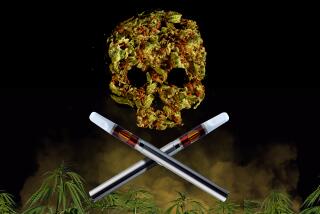Study Finds ‘Pesticide Rain’ Affecting Even Remote Areas
CHICAGO — First, there was acid rain. Now, according to a federal study to be released later this year, the newest environmental concern could be “pesticide rain.”
In the broadest study of its kind, the U.S. Geological Survey tested rainwater from 23 states during the height of the growing season last year and found detectable--although not necessarily harmful--levels of weedkillers in water from throughout the region.
Samples from Illinois, Iowa, Indiana, Kansas and Nebraska, where the chemicals are most heavily used on corn and soybeans, showed the highest concentrations. But small traces of herbicide-laced rainwater were also found in remote, presumably pristine locales such as Michigan’s Isle Royale National Park in Lake Superior and northern Maine, confirming suspicions that farm chemicals migrate through the atmosphere over long distances.
“We know there is transport over some relatively long distance, let’s say on the order of 10 to maybe 100 miles,” Donald Goolsby, a Geological Survey hydrologist and lead researcher on the project, said.
The cycle from land to air and back to land begins when large amounts of herbicides vaporize after being applied to farmland. The gases then are carried away in wind and clouds, only to return to earth later during storms.
Among the chemicals most often detected by the government were atrazine and alachlor, two herbicides widely used in American corn and soybean production. Both are suspected human carcinogens. Both have been banned in some other countries, and restrictions on atrazine have been instituted in this country as well. The Environmental Protection Agency standard for drinking water is 2 parts per billion of alachlor and 3 parts per billion for atrazine.
There is no federal standard for rainwater contamination. However, the average concentrations tested by the government fell within federal clean water drinking standards, the closest available measure.
The rainwater research is part of a larger regional investigation by the Geological Survey of agricultural chemicals in water sources. California is not a part of the study, and the herbicides under investigation are used in far smaller quantities in Western agriculture than elsewhere.
Nevertheless, Goolsby warned that the problem could actually be worse in California, where chemicals used on citrus groves and vegetable crops in the Central Valley might combine with urban smog.
If the Geological Survey were to do an exhaustive study of California rain, Goolsby said, researchers “are likely to find a lot more organic material in the atmosphere in that part of the country than you do in the Midwest.”
Some skeptics think the problem is not very serious.
Dennis Vercler, a spokesman for the Illinois Farm Bureau, said: “It sounds cavalier to say it’s so small as to be silly, but it borders on that.
” . . . What concern is it that rainwater contains a very small amount of a crop chemical in New York that came from the Midwest if there are no consequences, either from a health point of view or from an environmental point of view?”
Jennifer Curtis, a pesticide researcher for the Natural Resources Defense Council, conceded that contaminated rainwater is less of a risk to people than bad drinking water. But, she added, the government’s findings are still important.
“I think what we’re finding is that, the more we look for pesticides in the environment, the more we find them,” Curtis said. She expects that there will be research into the cumulative effects of chemically tainted ground and surface water combined with the effects of skin exposure to rainwater and vapor inhalation of the chemical residues.
“It’s real important for people to understand that the use of pesticides in one area is not necessarily a problem in that one area, but it could be much broader, and communities may well need to be concerned,” Curtis said. “We’re all neighbors in a sense.”
More to Read
Sign up for Essential California
The most important California stories and recommendations in your inbox every morning.
You may occasionally receive promotional content from the Los Angeles Times.










